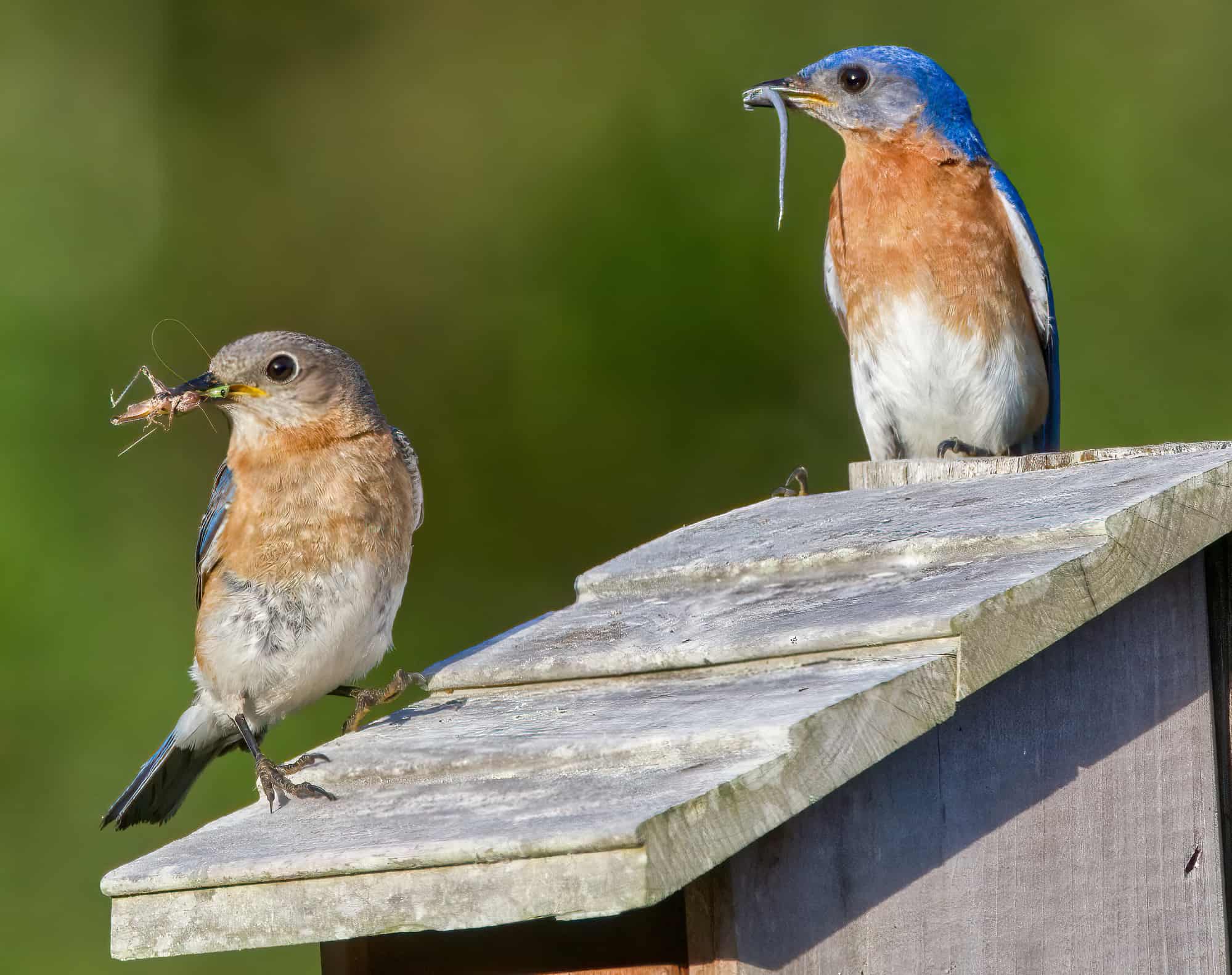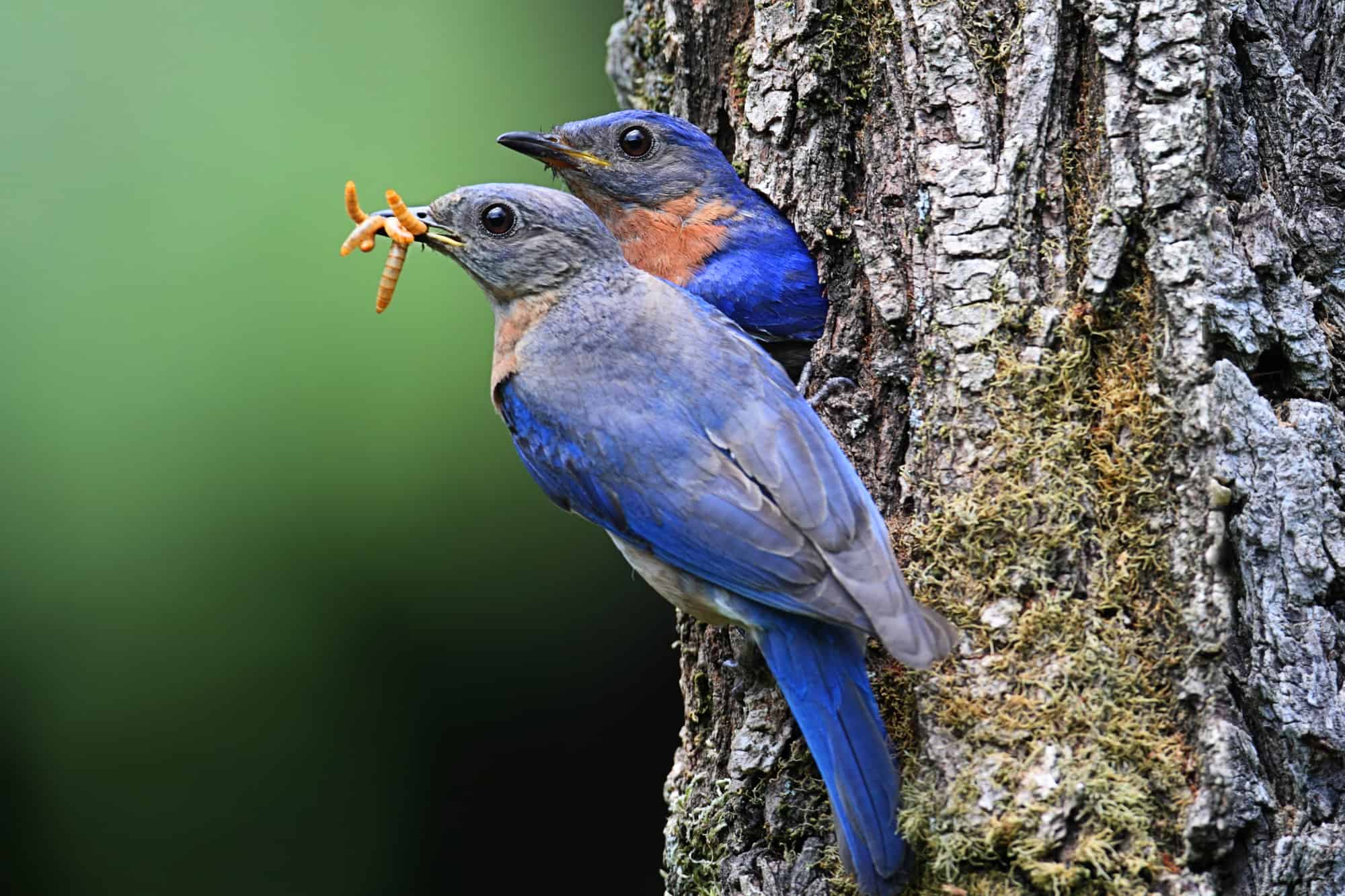North America is home to three kinds of bluebirds: the Eastern Bluebird, the Western Bluebird, and the Mountain Bluebird.
To answer the question, “Do bluebirds migrate,” you first have to determine which one you’re talking about. Each of these birds has slightly different migration habits.
Identifying Bluebirds

Before we discuss migration habits, let’s look at how to identify bluebirds!
For the most part, all three types of bluebirds are about the same size and have the same habitat preferences. Western Bluebirds are slightly smaller than the other two.
The male Eastern Bluebird has orange coloring that extends all the way from the throat to the neck and chest. His head, back, wings, and tail are blue. Females, on the other hand, are brown instead of orange, and gray instead of blue. They still have some blue on their wings, though–but it is much duller.
The male Western Bluebird has an all-blue head, throat, and neck and an orange chest. His back is chestnut brown. Females are almost entirely gray, with some light brown coloring on their chests.
As for the Mountain Bluebird male, his whole body is a beautiful sky blue, with even brighter pigmentation on his back. He has some gray feathers on his belly. The female Mountain Bluebird is mostly light gray, with some blue on her wings.
Eastern Bluebird Migration Habits
Some Eastern Bluebirds migrate; others don’t. The short answer is that northern-breeding Eastern Bluebirds migrate south for the winter, but those that already live in the southern part of the range don’t migrate at all.
This means that in the central corridor of Mexico and in the US Southeast, you’ll find Eastern Bluebirds year round. That’s because some live there all year, without migrating, and others have arrived for the winter from their northern breeding grounds.
In New England, the Midwest, and along the southeastern border between the US and Canada, you’ll find Eastern Bluebirds exclusively during the summer.
There is only a small corner of the world that sees Eastern Bluebirds exclusively in winter. Some northern breeding Eastern Bluebirds migrate to West Texas, the southwest corner of New Mexico, and the northeast corner of Mexico.
According to the Cornell Lab of Ornithology, Eastern Bluebirds are:
“Resident to medium-distance migrant[s]. Bluebirds leave breeding grounds in the north of their range to winter in the southeastern U.S. or Mexico. Populations in the northern part of their range are entirely migratory, spending winters in the southeastern United States or Mexico. Some fly as far as 2,000 miles between western Manitoba and Texas. Eastern Bluebirds from the southeastern U.S. may move short distances south or simply remain on their breeding territories all year.”
More facts About Eastern Bluebirds
Here are some more cool facts about Eastern Bluebirds from the Cornell Lab:
- Eastern Bluebirds produce more than once a year. According to the Cornell Lab, Eastern Bluebird hatchlings who mature before winter will leave their parents to become independent, but those who hatch later in the season will stay with their adults throughout the winter.
- Males find a cavity for building a nest and attract a mate to it by showing off some good nesting materials; then, the female builds the nest on her own and does all of the egg incubation by herself.
- Bluebirds have a diet of insects, fruit, berries, and occasionally larger vertebrate prey, including tree frogs, small snakes, salamanders, shrews, and lizards.
- The best way to attract Eastern Bluebirds to your birdfeeder is to provide mealworms.
- They will, however, stay in nest boxes. If you install a nest box before the breeding season and protect it from predators (snakes, cats, raccoons, bears, etc), you have a good chance of enjoying Eastern Bluebirds in your yard!
Western Bluebird Migration Habits

Let’s move on to the Western Bluebird!
This bird is another partial migrant, meaning that some of them migrate and others don’t.
The range of these birds is a bit hard to describe, and it is best to look at a range map to have a better understanding of when and where you can find these pretty little birds.
There are year-round residential areas in Mexico, surrounding the Four Corners, in California, and even in a few spots in the Pacific Northwest.
As for places where you will see Western Bluebirds during the breeding season but not for the winter, these are inland Pacific Northwest and Colorado.
The Cornell Lab describes their habits like this:
“Resident to medium-distance migrant. Some Western Bluebirds even as far north as British Columbia, Canada, stay there year-round. Bluebirds in mountainous areas may simply move down the slope to warmer elevations for winter. Others across the interior West depart their breeding grounds, and wintering birds begin to be seen in Arizona, west Texas, and northern Mexico by October and November. Unlike many songbirds, Western Bluebirds often migrate during the day.”
More facts About Western Bluebirds
Here are some more interesting things you might not know about Western Bluebirds:
- Even after they are mature, some young Western Bluebirds will help other birds at their nests. Specifically, they will assist their parents build and incubate their nests. This usually happens after the young Western Bluebird’s own nest has failed.
- Western Bluebird females will mate with more than one male; in fact, a study of Western Bluebird genetics found that 45% of their nests had young that were fathered by a male other than the one defending the nest.
- Western Bluebird males are very territorial birds who will viciously fight other males. Some of their fighting strategies include grabbing onto the other bird’s legs, knocking each other down, and pecking violently at each other with their sharp bills.
- Weighing in at only an ounce, Western Bluebirds consume 15 calories per day. Females who are raising hatchlings need 23 calories a day.
- Even though they are cavity-nesters, Western Bluebirds are not capable of building their own cavities. Instead, they live in holes created by other birds, like woodpeckers. You’ll find them in areas with lots of dead trees.
Mountain Bluebird Migration Habits

Mountain Bluebirds have a bigger range than Western Bluebirds, although there is some overlapping territory.
Mountain Bluebirds are rarely year-round residents of an area. Rather, they travel short distances between their summer and winter territories. Northern Mountain Bluebirds tend to migrate into areas that southern-breeding Mountain Bluebirds have just left, which creates a band of territory across the Great Basin.
Their breeding territory extends north from the US Interior West, through Canada, and into Alaska. They are inland birds, however, who generally aren’t found on the Pacific Coast.
Their winter grounds include California, the US South, and central Mexico.
The Cornell Lab says this about the Mountain Bluebird:
“Short- to medium-distance migrant. Mountain Bluebirds breed across western North America as far north as Alaska; they spend winters in as far south as central Mexico. Migrating flocks may consist of 20 to 200 birds.”
More Interesting Facts About the Mountain Bluebird
The Cornell Lab provides some additional fascinating facts about the Mountain Bluebird:
- Mountain Bluebirds are cavity-dwellers, but they also thrive in human-made nest boxes. One of the reasons for this is that nest boxes tend to be safer, both in terms of weather and predators.
- When a female Mountain Bluebird chooses a mate, she is much more interested in his nest site than his appearance.
- Like the Western Bluebird, the Mountain Bluebird is also very territorial. They will compete with other Western Bluebirds, but also with other birds that dwell in cavities, like Tree Swallows, Northern Flickers, and European Starlings. One of the strategies that Mountain Bluebirds use to claim good cavities is to arrive early in the season before other birds migrate to the area.
- The job of a male Mountain Bluebird during brooding and incubation is to provide the female with food. She will sometimes use the same strategies as a fledgling to solicit food–including opening her beak toward the sky and making a begging call. However, much of the time, she just keeps an eye out for her mate and then communicates with him through a little flick of the wings that she is hungry.
FAQs About Bluebird Migration
Let’s take a look at some of the most frequently asked questions about bluebirds and their migration patterns.
Where Do Bluebirds Go in the Winter?
The answer to this question is dependent upon where you live and what kind of bluebirds are in your area.
If you live in the southern US or Mexico, you are more likely to have bluebirds year-round. They won’t go anywhere in the winter. If you are in the Midwest, Interior West, New England, Canada, or Alaska, the bluebirds you see in the summer will likely move south during the winter.
Mountain and Western Bluebirds typically move into the Southwestern US and Mexico. Eastern Bluebirds stay in the American Southeast.
Do Bluebirds Use Their Houses in the Winter?
Bluebirds like nest boxes, but do they use those all year, or just in the summer when they are breeding and raising their young?
Bluebirds do visit their nest boxes outside of the breeding season. In fact, because females are generally only attracted to males who provide them with an excellent nesting spot, males are highly motivated to keep their nest box or cavity looking great throughout the year.
Do Bluebirds Come Back to the Same House Year After Year?
According to Bluebird Landlord: “Some bluebirds do return, and others don’t. According to two different studies, 26% – 44% of adult bluebirds return to breed at the same site where they nested the previous year. Therefore, there is about a one in three chance that the bluebirds you have in your nest box this year will return to the same box the following year.”
What Is the Best Way to Attract Bluebirds to My Yard?
Here are some tried-and-true methods for attracting bluebirds to your yard. For the most part, all three kinds of bluebirds (Eastern, Western, and Mountain) have the same preferences for nesting, food, and habitat, so these strategies should work no matter which bluebird is in your area.
- Build or purchase a bluebird nesting box! You will want to place it so that it faces the southeast, which protects it from wind and weather. The best nesting boxes are made from recycled plastic or cedar, as opposed to cheap wood that breaks down quickly. Higher-quality boxes also have an elevated mesh floor and protection against predators.
- Install your nesting box about 5-6 feet off the ground. It is best to post it to a 4×4 pole or stand-alone post, rather than a fence rail or on a tree.
- Whether or not you can provide a nesting box, you can often attract bluebirds to your yard if you use mealworms. Sometimes, suet and seed will work, too–but mealworms are your best bet! Bluebirds prefer to eat in open or semi-open areas, rather than an area with lots of tree and brush cover.
- Make your yard welcoming to songbirds by including a fresh water source and keeping it clean.

